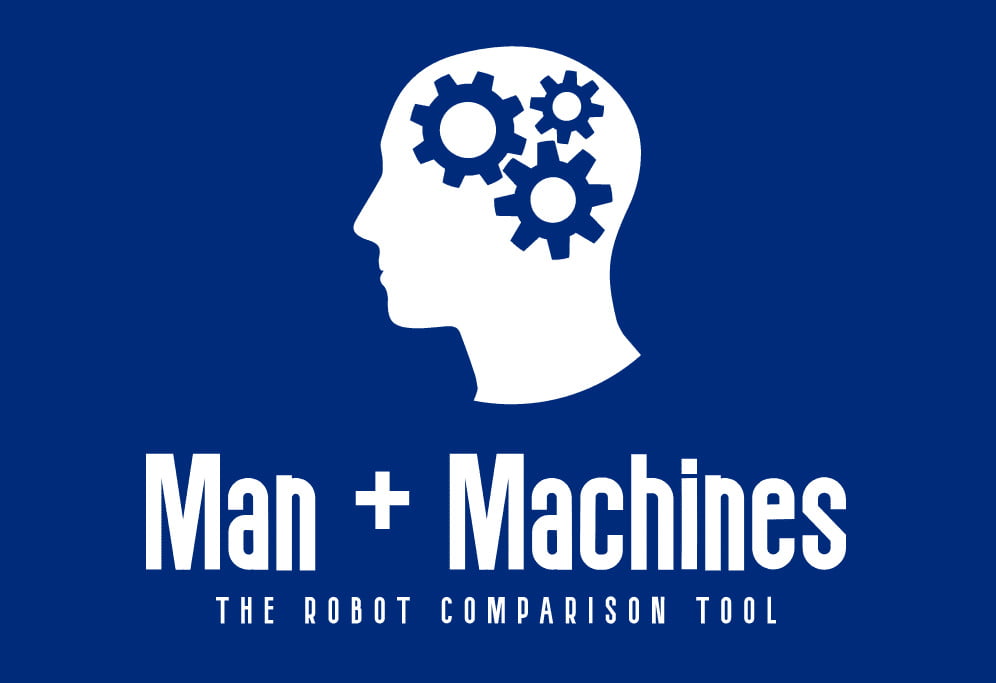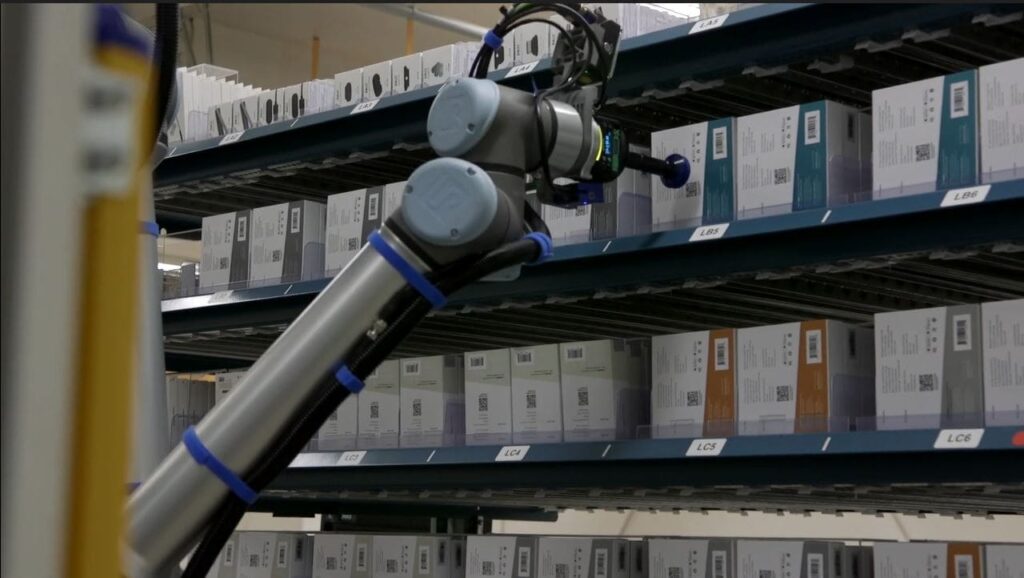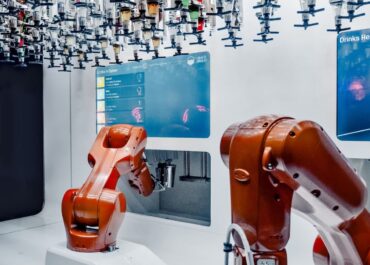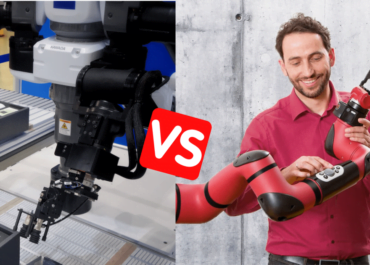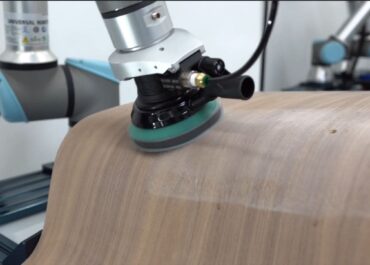Besides traditional automotive and metalworking industries, cobots are opening up automation opportunities for companies in various sectors.
These lighter, flexible and accessible robots have a much wider range of applications than traditional robots. And it would be a shame not to test them on your production or researching facilities.
Here are the industries that will benefit the most from them to improve productivity and working conditions for their employees.
Automotive

Since the 1980s, automotive manufacturers have intensively automated their production plants. Most automotive companies like Toyota, Hyundai, BMW are already using industrial robots to handle wielding and painting car parts.
But while these robotics system are expensive to repair, cobots are giving automakers new opportunities to automate other industrial applications. Thanks to easy implementation and flexible design, these light-weight robots are being increasingly used to handle precise assembly lines tasks, check outputs’ quality, and lift, move, and grasp heavy objects.
By working alongside workers, they speed up car production from Tier 1 OEMs to contractors and help scale up new design prototypes.
Electronics Manufacturing

Manufacturing electronics components has always been more difficult to automate. It needs more delicate and precise operations, like welding contact wires. So standard industrial robot have usually been of no help.
Collaborative robots, though, have become an interesting alternative for hardware makers. They find in them reliable solutions to boost their production with little defects and ROI. Well-trained cobots provide precise and highly repeatable movements with less cost.
As a result, electronics manufacturing is the second most growing market for collaborative robots, with almost 35% total market share supply in 2018. And it is just the start.
Agriculture

Placing robots on farms and other agricultural settings is definitely new. Farmers have always been reluctant to implementing robotics automation in seed sowing, fruit watering and picking. They believe that robots are not easy to transport and need too much engineering skills.
But countries like Singapore are showing the way to a kind of non-intensive urban agriculture. Urban farms often opt for the soft and productive touch of cobots to plant flowers and pollinate them in the right timing. They have also found their place in dairy productions and operations, milking cows at scale. Cobots also pack fresh products with incredible ease and carefulness.
As more mobile cobots are designed, farmers will surely adopt these solutions for mass production and cultivation. Some are already able to cut grass, harvest crops and crush grain.

Healthcare and pharmaceutical

Health care is one of the most advanced industries when it comes to manufacturing and production line automation, which is often why it attracts some of the most forward-thinking innovations.
So it’s no surprise that pharmaceutical companies have been very prompt to adopt cobots. They are using them for tasks such as assembling, packing, dispensing medication, and stocking shelves. These cobots replace workers with sterile and steady hands in often sensitive and demanding processes like drug production and developments.
Health care companies also turn to cobots for other more technical tasks, such as medical coding. The standards must be precise, and errors can derail important procedures — from finding cancer to providing timely care. Cobots can achieve these tasks reliably. They are so versatile that they are finding their way into areas of health care like operating rooms and dental labs. Meanwhile, their human workforce can spend time in more valuable tasks, such as customer interactions, which will lead to better service.
Packaging and Palletizing

As companies strive to stay competitive in a global economy, packaging has become an integral part of manufacturing operations. Manufacturers increasingly need reliable and product-adapted packages and pallets, and robots are helping them with that. In 2017, the use of robots in packaging was estimated at $4.7 billion. By 2025, global revenue is projected to reach $11.3 billion.
Very good at handling delicate and as small items as egg package, cobots are an even popular option for them to increase accuracy, improve efficiency, throughput, quality and reduce injuries and costs in packaging. The last thing manufacturers want is for a product to be damaged during shipping. By using cobots, this becomes therefore much less of a possibility.
Food

The food and beverage industry is highly susceptible to accidents and injuries. In addition to exposure to hot food and chemicals, workers have to handle heavy objects, work in confined spaces and high-stress environments. That’s why, the food and beverage companies are also increasingly turning to robotic technology to help mitigate some human risks facing their sector.
Cobots provide food and beverage plants with more flexibility. They can replace human workers for some tasks, such as picking and packing, and free up workers to do other work, such as quality checking samples. The food and beverage industry is already using cobots to help increase efficiency and reduce costs, and the technology is expected to become even more prevalent over the next few years. In a 2017 report, Technavio projected that the global cobots sector would grow at a Compound Annual Growth Rate (CAGR) of 40.2% from 2017 to 2025, and that by 2022, more than 20,000 cobots will be installed in the food and beverage industry.
Metalwork

Today, metalworking companies are already seeing the benefits of automating processes like metal forming, welding, finishing, assembly, and machining. But, over the last decade, cobots have allowed companies of all sizes to reap the benefits of robots in a larger scale.
Cobots are a real asset for metalworking companies looking to increase production speed, improve quality, and reduce labor costs. They are especially good at automating processes that require hand-operated, repetitive motions, but also dangerous and dirty. They enable metalworking companies to scale their manufacturing and increase profitability.
Therefore, while cobots have been used in metalworking since 2007, their use has increased dramatically in the last few years. According to a survey by IHS, a research firm, over 100,000 cobots were installed in metal manufacturing in 2015.
Scientific Research & Education

Among all their missions, robots and automation are increasingly playing a significant role in laboratories, from performing complex work to assisting in more mundane tasks.
A wide range of scientific research applications—from chemistry to biomedical and lifescience —are beginning to use robots and automation on tasks that were once reserved for humans. They can handle test tub sorting and labeling, transport laboratory specimens and mix compounds to speed up drug analysis and cell cultivation.
Research reported in 2016 by Grand View Research estimated that the global market for robotics in laboratories will grow to $1.9 billion by 2024, up from $1.2 billion in 2016.
But cobots are also becoming a must-have for education purposes. By being easy-to-use and safe for students, they are a popular tool in technical and scientific classroom projects. Cobots teach students the valuable skills of automation and help them put in practice sophisticated lessons and knowledge.
Logistics and warehousing

With the rise of globalization, trade has become more dynamic than ever before. But the supply chain has become also more fragmented and complicated.
While a supply chain manager in the past could only rely on his intuition and experience to predict how fast his products would travel from one point to another, today’s warehouse operations require constant optimization.
To adapt to change, warehouses increasingly use robots for picking, packing and shipping operations, as well as order fulfillment and replenishment. But while robots and software enable warehouses to be more productive, they also require sophisticated logistics and transportation planning. This is because the transportation and logistics network must be optimized to connect warehouses and retailers to customers in a timely and cost-effective manner.
So logistics companies are turning to cobots to automate warehouse activities with more versatility. Workers can program cobots very easily for new tasks and make them process tasks within tight deadlines. And for this reason logistics companies are increasingly adopting them.
Furniture & Equipments

In the equipment industry, there are thousands of different variations of furniture, each requiring different processes. And this need for personnalization is just the beginning.
Due to this very nature, furniture manufacturing requires a high amount of manpower and is highly susceptible to human mistakes. Meanwhile, it has become increasingly difficult to attract and keep workers. So the furniture industry is currently ripe for automation.
Robots are indeed faster and more consistent. They can complete complex tasks in a fraction of the time. But, when handling furniture, the robot must be programmed to handle specific positions, as well as handle a variety of pressure points. Furthermore, the robot has to be able to navigate around furniture, which means it must have vision.
That’s why cobots have become a popular choice among furniture makers. Being smaller and cheaper, they reduce production costs, human error and increase the efficiency of factories.
